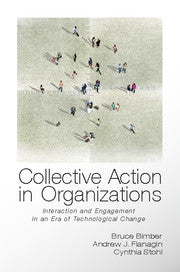Freshly Printed - allow 8 days lead
Couldn't load pickup availability
Collective Action in Organizations
Interaction and Engagement in an Era of Technological Change
Explores how people participate in public life through organizations. The authors examine three organizations and show surprising similarities across them.
Bruce Bimber (Author), Andrew Flanagin (Author), Cynthia Stohl (Author)
9780521191722, Cambridge University Press
Hardback, published 29 February 2012
240 pages, 9 b/w illus. 17 tables
23.5 x 15.8 x 1.5 cm, 0.45 kg
“Collective Action in Organizations offers a pathbreaking analysis of the role of new communication technologies in collective action. Its nuanced analysis reconceptualizes civic participation in terms of multiple levels of engagement and interaction afforded by various modes of communication, from face-to-face interaction to newly-minted social networking technologies. Bimber, Flanagin, and Stohl offer a theoretically sophisticated and empirically supported framework that reaffirms the importance of organizations in what appears to be the increasingly fragmented and individualized world of online participation, protest, and politics. Their model and research shows the multiple ways in which citizens connect with civic organizations and how communication technologies figure in this process. It picks up where Putnam’s Bowling Alone leaves off, revealing some surprising new wrinkles and dynamics that Putnam and his successors have not fully considered. This engaging book makes us rethink the role of new communication technologies in politics, public life, and in the lives of citizen participants.” —Marshall Scott Poole, Professor of Communication and Director of the Institute for Computing in the Humanities, Arts, and Social Science, University of Illinois Urbana-Champaign
Challenging the notion that digital media render traditional, formal organizations irrelevant, this book offers a new theory of collective action and organizing. Based on extensive surveys and interviews with members of three influential and distinctive organizations in the United States - The American Legion, AARP and MoveOn - the authors reconceptualize collective action as a phenomenon in which technology enhances people's ability to cross boundaries in order to interact with one another and engage with organizations. By developing a theory of Collective Action Space, Bimber, Flanagin and Stohl explore how people's attitudes, behaviors, motivations, goals and digital media use are related to their organizational involvement. They find that using technology does not necessarily make people more likely to act collectively, but contributes to a diversity of 'participatory styles', which hinge on people's interaction with one another and the extent to which they shape organizational agendas. In the digital media age, organizations do not simply recruit people into roles, they provide contexts in which people are able to construct their own collective experiences.
1. Involvement in organizational collective action in an era of technological change
2. The contemporary media environment and the evolution of boundaries in organization-based collective action
3. The collective action space
4. The American Legion, AARP, and MoveOn in collective action space
5. Exploring collective action space
6. Participatory styles, the individual, and the contemporary organization.
Subject Areas: Media, information & communication industries [KNT], Politics & government [JP]


